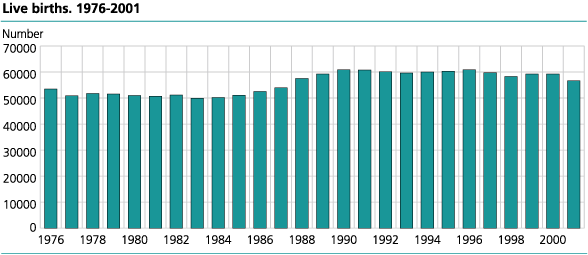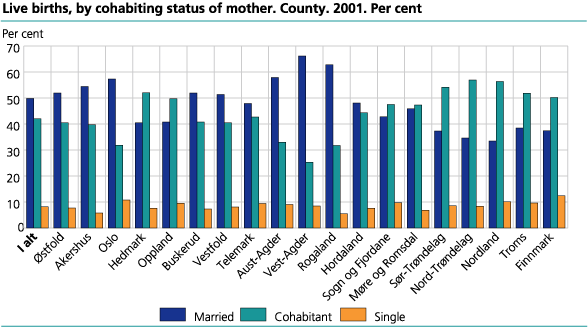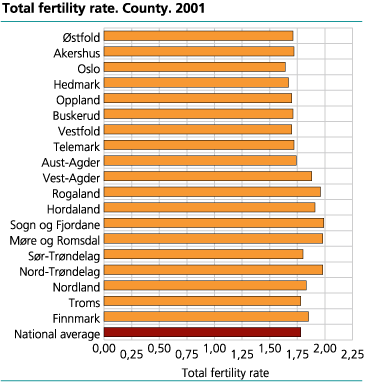Content
Published:
This is an archived release.
42 per cent born to cohabiting parents
56 700 children were born in 2001, this is 2 500 fewer than the year before. For the first time since 1987 there were less than 57 000 births. 42 per cent of the children born in 2001 had cohabiting parents, near 50 per cent had married parents and 8 per cent had single mothers.
From 1989-2000, except 1998, the birth rates have been stable around 60 000. In 2001 56 700 children were born, a decrease of 2500 from the year before. The total fertility rate, which tells the total number of children per woman on average, has varied between 1.85 and 1.93 in the period. In 2001 the fertility rate was at 1.78, a decrease from 1.85 in 2000. There has been a decrease in first births, second births and later births; the decrease has been the largest among the third and fourth births.
Sweden and Denmark has a lower fertility rate than Norway with 1.57 (2001) and 1.77 (2000) respectively.
42 per cent had cohabiting parents
42 per cent of the children born in 2001 had cohabitingparents, near 50 per cent had married parents and 8 per cent had single mothers. The corresponding rates for 2000 was 41, 49 and 10, respectively. In all counties north of Sør-Trøndelag, including Hedmark, more than 50 percent of the children had cohabitating parents. The lowest rate of cohabitating parents was found in Vest-Agder with 25 per cent, whereas 66 had married parents.
Especially the firstborn (65 per cent) have cohabitating parents or single mothers. The parents are more often married when the next child is born. The average age of cohabitating parents was 28.9 years for the mother and 31.7 years for the father, for those in wedlock the number is somewhat higher with 31.0 for the mother and 34.0 for the father.
Age stabilization for first time births
There has been a steady decrease in the fertility of most age groups. For women in the youngest cohort (15-19 years) and for women in the oldest (above 35 years) there has been only insignificant changes in the fertility rate from 2000 to 2001. For women in the 20s the decrease is a continuation of a long-term trend (with the exception of the 25-29 year olds in 1998). On the other hand, the numbers for women aged 30-34 years the birth numbers are decreasing after several years of increase.
The mothers' mean age for first births was 27.5 years in 2001. The mean age for first births is still increasing, but not at the same rate as early in the 1990s. From 1991 to 1996 the numbers increased by 1 year, from 1997 to 2001 by 0.5 year.
Highest fertility in the west, largest decrease in the north
The fertility was highest in Rogaland, Møre og Romsdal and Nord-Trøndelag, with a total fertility rate varying from 1.90 to 1.99. The fertility rate was lowest in Oslo and Hedmark, with a total fertility rate of 1.64 and 1.67.
All counties saw a decrease in their fertility from 200 to 2001, however the decline varies from county to county. The decline was at its peak in the counties where the fertility rate traditionally has been highest. Largest was the decrease in Finnmark where the fertility rate fell from 2.08 to 1.85, followed by Troms and Aust-Agder.
More multiple births
Last year, 1035 multiple births were registered, 1016 of these were twin births, 19 triple births and one quadruple birth. Multiple births represented 18.5 births per 1000 births. The rate of multiple births has risen during the 1990s. In 1982 and 1983 there were only 10.4 and 13.6 multiple births per 1000 births.
A new statistics measuring different ways of living together is included
Births of cohabitating parents are included in the statistics for the first time. Earlier statistics only had the official marital status codes, which means that the statistics was divided in two: born in wedlock or not. This change is more thoroughly described in 'about the statistics'.
Tables:
- Table 1 Live births and late foetal deaths. 1951-2001
- Table 2 Live births, by month. 1971-2001
- Table 3 Confinements of single and multiple births. 1956-2001
- Table 4 Confinements of single and multiple births, by sex. 1991-2001
- Table 5 Age-specific fertility rates and total fertility rate. 1961-2001
- Table 6 Average age at birth. 1946-2001
- Table 7 Mean age of parents at all birth. County. 2001.
- Table 8 Total fertility rate, by county. 1968-2001 (Corrected 06.01.2003)
- Table 9 Confinements and births. County. 2001
- Table 10 Live births, by age of mother and parity. 2001
- Table 11 Live births, by parity. 1978-2001
- Table 12 Live births, by age of mother and father. 2001
- Table 13 Live births, by citizenship of mother and father. 2001
- Table 14 Live births, by cohabitation status and county. 2000 and 2001
- Table 15 Live births by age of mother and cohabitation status. 2001
- Table 16 Live births by age of father and cohabitation status. 2001
- Table 17 Live births, by parity and cohabitation status. County. 2001
- Table 18 Live births, by mean age of mother and father and cohabitation status. County. 2001
Contact
-
Statistics Norway's Information Centre
E-mail: informasjon@ssb.no
tel.: (+47) 21 09 46 42
-
Espen Andersen
E-mail: espen.andersen@ssb.no
tel.: (+47) 92 61 00 46
-
Ane Margrete Tømmerås
E-mail: ane.tommeras@ssb.no
tel.: (+47) 91 99 29 62
-
Oppdrag befolkningsstatistikk
E-mail: befolkning@ssb.no



